SUNGKYUNKWAN UNIVERSITY (SKKU), SEOUL, KOREA
- Research Team Develops Catalyst to Convert Carbon Dioxide to Petrochemical Intermediate
- Novel Host Material to Obtain Highly Efficient Upconversion Luminescence at
a Single-band Wavelength Discovered - Study on Dirac Electrons in a Dodecagonal Graphene Quasicrystal: Construction of
a 4-Dimensional Space in a 2-Dimensional Material - Degradation-Regulatable Architectured Implantable Macroporous Scaffold (Dr-AIMS) Developed
- Doping Technology by Baking Metal Oxide Thin Film for a Short Time Developed
- Muscle-Mimetic Cell-Laden Nanofiber Using 3D Cell-Electrospinning Enhancing
Muscle Regeneration with Anisotropically Arranged Nanofibers - SKKU Research Team Participates in IBS Dark Matter Study
- Decoupling Structure and Electronics Leads to Purely Electronic Transition
- Research on the Role of Protein Arginine Methyltransferase 1 in Preventing Heart Failure
- Biocatalysts for Anti-Inflammatory Drug Synthesis

The foundation for producing clean fuel and petrochemical products using carbon dioxide has been created. Prof. Jongwook BAE and his research team have developed a way to produce a petrochemical intermediate from carbon dioxide using a catalyst.
The need for a way to efficiently remove carbon dioxide has increased due to the exhaustion of oil resources and global warming. Research has been done on catalyst technology that synthesizes petrochemical materials with the use of different intermediates such as methanol and dimethyl ether. However, it remained incomplete as they could not solve the issue of the efficiency decreasing after deactivation of the catalyst.
The research team was able to induce synthesis of dimethyl ether from carbon dioxide by developing a catalyst synthesized with alumina and nanostructured copper. The alumina that has been inlaid with 5~8 nm of patterned pores improved the thermal stability, and the catalyst remained stable/efficient even in high temperature/pressure conditions; the rate of conversion for carbon dioxide improved about 30% as they included oxide from gallium or zinc with the catalyst.
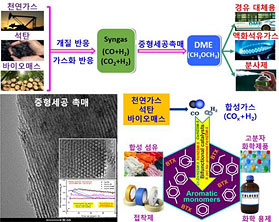 Furthermore, the research team produced a structurally stable mesoporous alumina and zeolite to develop a way of synthesizing basic distillate (olefin, benzene, toluene, xylene, etc.).
Furthermore, the research team produced a structurally stable mesoporous alumina and zeolite to develop a way of synthesizing basic distillate (olefin, benzene, toluene, xylene, etc.).
Prof. Bae explained, "The product of this research is a highly efficient and stabilized catalyst technology to convert carbon dioxide, which is the main source of the global warming. It will become a generic technology that synthesizes clean energy and petrochemical intermediates."
This research was done under the support of Ministry of Science and ICT, and National Research Foundation of Korea's C1 Gas Refinery R&D Center. On December 10th, the result of the research was published in the international scientific journal "ACS Catalysis".

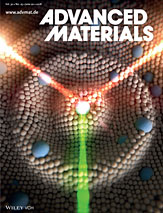 Lanthanide trivalent ions (Ln3+) embedded in an inorganic host solid are capable of "upconversion", which is the fascinating ability to convert multiple low-energy photons into a higher-energy photon. Upconversion luminescence suggests the promise of Ln3+-doped materials in emerging novel applications, such as energy harvesting for solar cells or deep tissue optogenetics.
Lanthanide trivalent ions (Ln3+) embedded in an inorganic host solid are capable of "upconversion", which is the fascinating ability to convert multiple low-energy photons into a higher-energy photon. Upconversion luminescence suggests the promise of Ln3+-doped materials in emerging novel applications, such as energy harvesting for solar cells or deep tissue optogenetics.
However, it has been difficult to improve the upconversion efficiency because the upconversion efficiency and the upconversion emission spectrum are determined by complex interaction between the host material and the lanthanide ion at an atomic level.
Prof. Dong Hwan KIM, a professor at the Department of Chemical Engineering, has developed a novel host material that does not have a short-range order (1st coordination order) by liquefying and quenching the host material using a laser to maximize the host interactions, and thus realizing highly efficient upconversion luminescence at a single-band wavelength.
The results of this study are significant not only in scientific fields, but also in real world applications because the intrinsic limitations of the conventional host materials are overcome. This new material will be used in macroscale laser technologies and photonic integrated circuit devices.
Please find out more details about this research from the published article:
B. S. Moon, H. E. Kim and D. H. Kim, "Ultrafast Single-band Upconversion Luminescence in a Liquid-quenched Amorphous Matrix", Advanced Materials, 30, 1800008 (2018)(featured on the front cover):
https://onlinelibrary.wiley.com/doi/abs/10.1002/adma.201800008

Quasicrystal is an unusual solid structure that was first experimentally observed in the 1980s by Nobel Laureate Dan Shechtman. In a typical solid, the constituent elements are arranged with a certain periodicity called a lattice structure, and in this case, it has both translational and rotational symmetry. However, quasicrystals have a distinct structure with only rotational symmetry, and have fractal structure with self-similarity.
In addition, there have been many theoretical and experimental studies on the interaction between two graphene layers, and unusual physical phenomena such as Mott insulators and the superconducting phenomenon have also been reported in the academic community. Prof. Joungreal AHN's research team has recently published a study on two-dimensional quasicrystals using two graphene layers in accordance with these research trends.
In this study, instead of stacking two separated graphene layers, two-dimensional graphene quasicrystals were synthesized by epitaxially growing two graphene layers with a rotation angle of 30 degrees. Then, the first special quasicrystal with Dirac fermions was discovered. The synthesized graphene quasicrystals were confirmed to have 12-fold symmetry and fractal structure which have not been seen in general crystal structure. It is expected that the physics in 4-dimensional space represented by the 4D quantum hall effect can be observed through this two-dimensional graphene quasicrystal.

Prof. Yongtaik LIM`s research team at SKKU Advanced Institute of Nanotechnology (SAINT) has developed a degradation-regulatable architectured implantable macroporous scaffold (Dr-AIMS) for spatiotemporal controlling immunosuppressive factors in tumor microenvironment, resulting in more efficient combination cancer immunotherapy.
The Dr-AIMS was fabricated based on hyaluronic acid, the intrinsically existing biopolymer in humans, with the ability to regulate the degradation kinetics for varied applications.
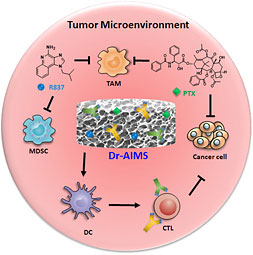 With scaffold implantation after surgery, the immunosuppressive cells (MDSC: Myeloid-derived suppressor cells; TAM: Tumor-associated macrophages) related with tumor recurrence and metastasis can be controlled and the ability of DCs and T cells can be reinvigorated with reduced side effects of chemodrugs and immune checkpoint antibodies.
With scaffold implantation after surgery, the immunosuppressive cells (MDSC: Myeloid-derived suppressor cells; TAM: Tumor-associated macrophages) related with tumor recurrence and metastasis can be controlled and the ability of DCs and T cells can be reinvigorated with reduced side effects of chemodrugs and immune checkpoint antibodies.
Through this approach, the drawbacks of IV injection, including low targeting efficacy and varied side effects, could be addressed. Furthermore, it can be developed as an on-demand drug delivery system based on the analysis of tumor tissues.
Please find more details about this research from the published article:
L. Ren, and Y. T. Lim, "Degradation-regulatable Architectured Implantable Macroporous Scaffold for the Spatiotemporal Modulation of Immunosuppressive Microenvironment and Enhanced Combination Cancer Immunotherapy", Advanced Functional Materials, 201804490 (2018).

Prof. Jung Kyu KIM (Chemical Engineering) and his research team achieved the development of a novel rapid sol-flame process to modify the energy state and electronic structure of nanoparticulated metal oxide films and their application for the charge transport/selective layer of perovskite solar cells with high efficiency.
To further increase the open-circuit voltage (Voc) of perovskite solar cells (PSCs), many efforts have been devoted to doping the TiO2 electron transport/selective layers by using metal dopants with higher electronegativity than Ti. However, those dopants can introduce undesired charge traps that hinder charge transport through TiO2, so the improvement in the Voc is often accompanied by an undesired photocurrent density-voltage (J-V) hysteresis problem. Herein, it is demonstrated that the use of a rapid flame doping process (40s) to introduce cobalt dopant into TiO2 not only solves the J-V hysteresis problem but also increases the Voc and power conversion efficiency of both mesoscopic and planar PSCs.
The reasons for the simultaneous improvements are two folds. First, the flame-doped Co-TiO2 film forms Co-Ov (cobalt dopant-oxygen vacancy) pairs and hence reduces the number density of Ti3+ trap states. Second, Co doping upshifts the band structure of TiO2, facilitating efficient charge extraction.
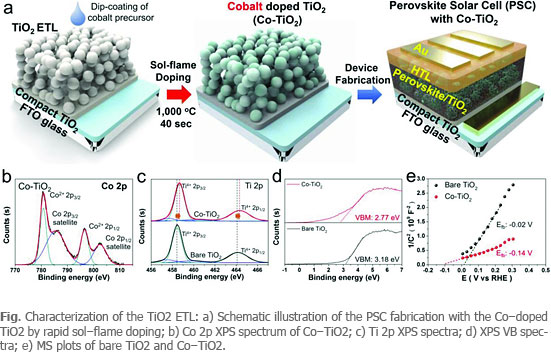
As a result, the flame doping of Co increases the efficiency from 18.5% to 20.0% while reducing the hysteresis from 7.0% to 0.1%.
This research is expected to develop a wide variety of applications that use metal oxide such as information electronic devices, memories, and displays as well as energy conversion materials such as solar cells. The results of the research were published in the world's leading journal "Advanced Energy Materials" on October 15, 2018.
Please find more details about this research from the published article entitled "Resolving Hysteresis in Perovskite Solar Cells with Rapid Flame-Processed Cobalt-Doped TiO2".

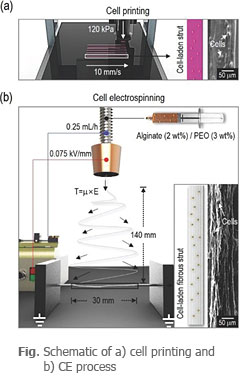 Prof. Geun Hyung KIM and his research team reported that they have successfully aligned a nanofibrous structure by producing live myoblast cells and bioink suitable for electrospinning. Nano-muscular fibers implanted with live myoblast cells acted as if they were real muscle tissue and accelerated the regeneration of muscle tissue by guiding the muscle cell to grow in a uniaxial direction.
Prof. Geun Hyung KIM and his research team reported that they have successfully aligned a nanofibrous structure by producing live myoblast cells and bioink suitable for electrospinning. Nano-muscular fibers implanted with live myoblast cells acted as if they were real muscle tissue and accelerated the regeneration of muscle tissue by guiding the muscle cell to grow in a uniaxial direction.
Tissue Regeneration Engineering is a field of study developed to improve the regeneration process of damaged tissues/organs by inserting a biological substitute, which is called a "scaffold". 3D cell-printing and electrospinning have been widely used for this process. However, the cells cultured by 3D cell-printing and electrospinning grew randomly, which was a serious problem for muscles that required their cells to be aligned for proper regeneration.
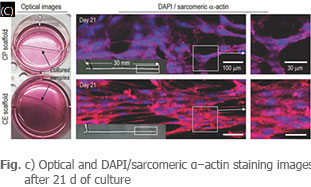 To control cell morphology, they have developed electrospinning into a cell-electrospinning process. The research team used a biocompatible hydrogel to generate cell-laden nanofibers. Also, the hydrogel was added with a material with high processability to produce a bioink, which was applied with high-voltage direct current. After this, myoblast-laden nanofiber can be generated with an aligned pattern.
To control cell morphology, they have developed electrospinning into a cell-electrospinning process. The research team used a biocompatible hydrogel to generate cell-laden nanofibers. Also, the hydrogel was added with a material with high processability to produce a bioink, which was applied with high-voltage direct current. After this, myoblast-laden nanofiber can be generated with an aligned pattern.
The myoblast-laden nanofibers showed over 90% of initial cell viability, which was a sign that it overcame the problem of low cell viability from the previous conventional cell-electrospinning process. Moreover, the cell alignment and differentiation improved threefold in comparison to the 3D cell-printing process.
The myoblast-laden nanofibers induced cells to grow in a uniaxial direction, which assists the regeneration of skeletal and cardiac muscle. Prof. Kim said, "This was the first case to successfully produce cell-laden nanofibers in a uniaxial arrangement. It suggested it may be possible for it to become a new method of regenerating an aligned tissue structure.
This research was supported by a grant from the National Research Foundation of Korea funded by the Ministry of Education, Science, and Technology. It was selected as the cover page for a world-renowned journal, "Small".

A team led by Prof. Karsten Rott of SKKU's Department of Physics has joined the Cosine-100 Collaborative Research Unit of the Institute for Basic Science (IBS), in paving the way for a long-standing controversy surrounding the dark matter signal observed by the DAMA Experiment.
The results of this research were published in the online edition of Nature (IF 42.351) on December 6th. In the paper, data from the Cosine-100 Experiment suggested that there is insufficient evidence that the signal detected by the DAMA Experiment is caused by dark materials, and disproved most of the theories based on its results.
Currently, two SKKU graduate students are participating in the Cosine-100 Experiment and are conducting a detector simulation. Prof. Rott's team has been participating in this experiment from the beginning, and is contributing by monitoring the data from the detector.
"The Cosine-100 Experiment will continue to collect data. We hope that we will be able to fully understand the anomalies observed by the DAMA Experiment," said Prof. Rott, "Although this result does not directly identify the presence of dark matter, it may have discovered a new phenomenon that we do not know yet."
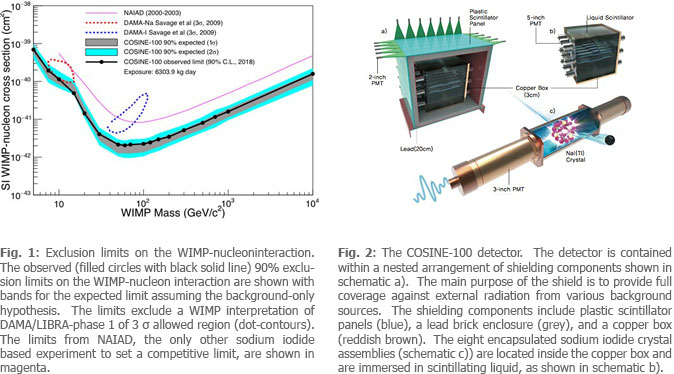

Prof. Jaichan LEE at Sungkyunkwan University, Korea, Prof. Chang-Beom EOM at University of Wisconsin, Madison, USA, and coworkers reported they were able to initiate a metal-insulator transition in VO2 occur that changed electronically without a change in structure by decoupling the structure and electronics.
Metal-insulator transition in strongly correlated materials has been a central issue in fundamental science and technology. The metal-insulator transition is typically accompanied by structural phase transition, which makes it difficult to unveil the primary mechanism of the transition. Extensive debate has continued about which is the primary mechanism, either electron-lattice (Peierls transition) interaction or electron-electron interaction (Mott transition).
VO2 is an archetypal correlated material and specifically has a metal-insulator transition near room temperature, which provides great advantages for device applications. However, device application has been limited because of the coupling of electronic and structural transitions.
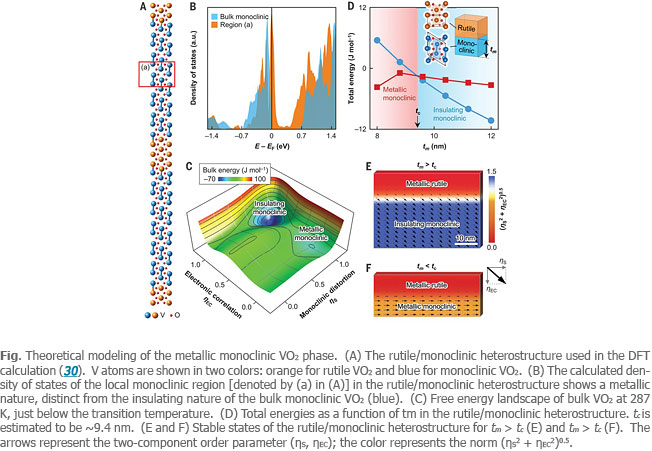
Prof. Jaichan Lee said that this discovery and approach could be extended to correlated materials to unveil many unconventional phenomena and get a wide variety of material functionality.
The article is published in "Science" (2018).

Cardiac disease is one of the most common adult diseases and a leading cause of death worldwide. The increasing rate of cardiac disorder is due to a westernized lifestyle and aging population. This has made developing a treatment by researching the pathogenesis of cardiac disorders an urgent matter.
The cause of most cardiac disorders is the regenerating process of the cardiomyocyte. When the cardiomyocyte cannot self-regenerate, it chooses to extend or increase in size, resulting "Cardiac hypertrophy". Cardiac hypertrophy is an adaptive response to physiological and pathological stimuli. However, pathological cardiac hypertrophy leads to heart failure.
This study exhibited that mice with deficiency of cardiac PRMT1 showed a rapid progression to dilated cardiomyopathy and heart failure within 2 months of birth. Heart failure was accompanied with cardiomyocyte hypertrophy and fibrosis. This study was conducted by prof. Jong Sun KANG and research team discovered that PRMT1 is essential for the maintenance and survival of cardiac function.
CaMKII δ (Calcium/calmodulin-dependent protein kinase II δ), which was identified as the main target of this study has been linked with maintenance of Ca2+ homeostasis by phosphorylating various proteins important for excitation–contraction coupling and cell survival including ion channels. Thus, they proved that dysregulation of CaMKII δ is closely linked with myocardial hypertrophy and heart failure. However, the mechanism that regulates CaMKII activity is still in need of further research.
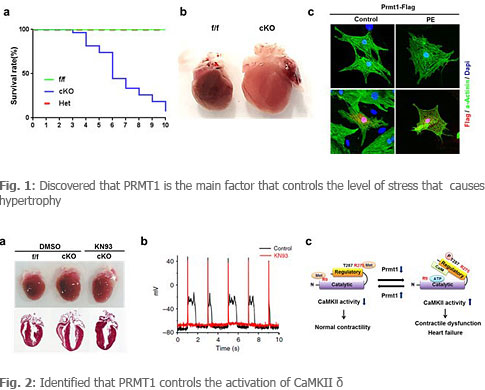
The most important finding of this study was the fact that the protein arginine methyltransferase 1 (PRMT1) is essential for preventing cardiac CaMKII hyperactivation. The level of active CaMKII is significantly elevated in PRMT1-deficient hearts or cardiomyocytes. PRMT1 interacts with methylates CaMKII, leading to the inhibition. Accordingly, pharmacological inhibition of CaMKII restores contractile function in PRMT1-deficient mice. Thus, our study suggests that PRMT1 is a critical regulator of CaMKII to maintain cardiac function and a potential therapeutic target of cardiac disease.

So far, chemical synthesis has been used to produce fine chemicals such as medicine. However, the synthesis carries problems such as low economic efficiency and use of hazardous substances. The use of environment-friendly biocatalysts is one of the solutions to overcome these problems. The key advantages of the biocatalysts are the specificity of enzymes to substrates, reactions, and stereoisomers, which can reduce the complexity involved in the process of chemical synthesis. Another great advantage is that it reacts in conditions at mild temperature, on atmospheric pressure, or in aqueous solution. For these reasons, the biocatalyst is under the spotlight as the core part of green chemistry, with less by-products and hazardous waste produced during the synthesis process.
Protein engineering tools are applied in developing biocatalysts, by improving enzyme activities. There are two main streams in protein engineering: 1) directed evolution (the topic of Nobel Prize on Chemistry, 2018) and 2) structure-based rational design. Rational design is only applicable when the structure and mechanism of the protein are available, but it is more efficient than the directed evolutionary approach.
Ketoprofen, a non-steroidal anti-inflammatory drug, is an analgesic or a fever reducer, releasing inflammation and pain mediated by rheumatoid arthritis or osteoarthritis. It is used in external painkillers in forms of gel or patches. Ketoprofen has two stereoisomers, S- and R-form, with the S-form showing higher drug effect. The US Food and Drug Administrator guides that a stereo isomeric drug should be an enantiomer, not a racemate. The ketoprofen from racemate is required to be highly purified.
For high purity of ketoprofen in synthesis, Professor Kyeong Kyu KIM's group identified the 3D structure of the esterase Est-Y29 complex, which is extracted from the metagenomic library originated from soil in Korea with (S)-ketoprofen in high resolution using X-ray crystallography. It showed that aromatic residue in substrate-binding pocket of the enzyme positively affects enantioselectivity of Est-Y29 to S-form by the interaction with ketoprofen ethyl ester (a precursor of ketoprofen). Based on 3D structural information of the complex, Kim's group designed a mutant that has increased aromaticity in the substrate binding pocket and consequently succeeded in developing a new enzyme whose enantioselectivity toward (S)-ketoprofen was about 5 times higher compared to wild-type.
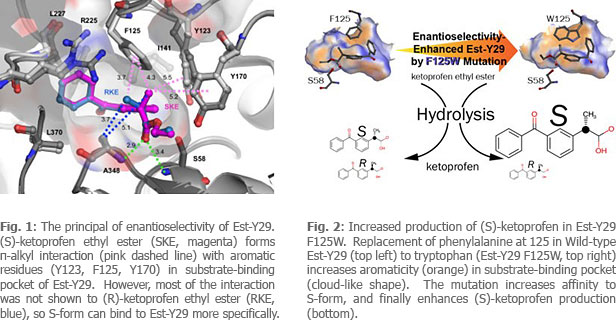
This research is noteworthy since there was a successful increase in protein function using rational design, and the research was published in ACS Catalysis Online on December 24, 2018. Professor Kyeong Kyu Kim explained the significance of the research as follows, "In the research, we developed a new biocatalyst which may displace chemical catalysts, using a 3D structure-based, protein engineering approach. It also proposes a potency for production of effective medicines such as ketoprofen, through environment-friendly methods."


























